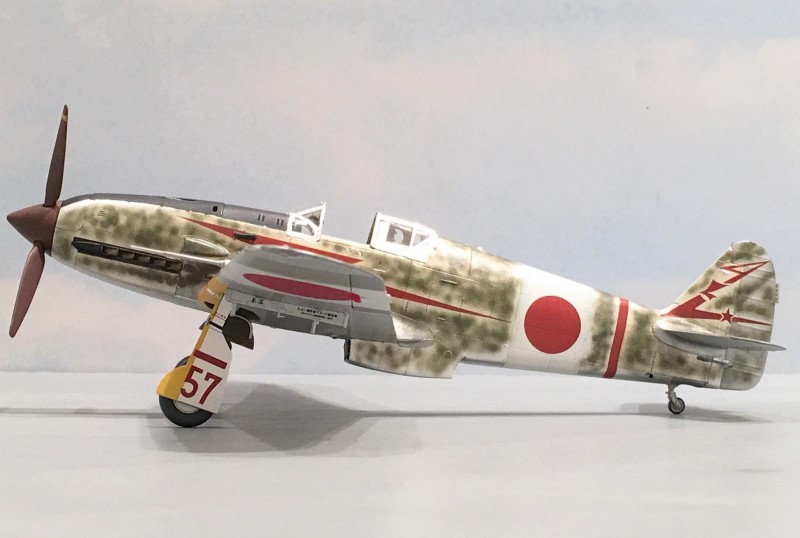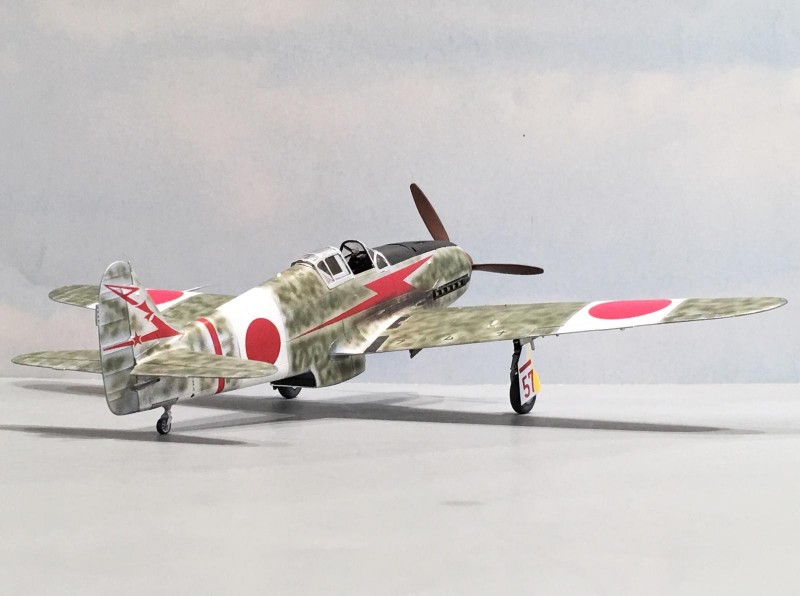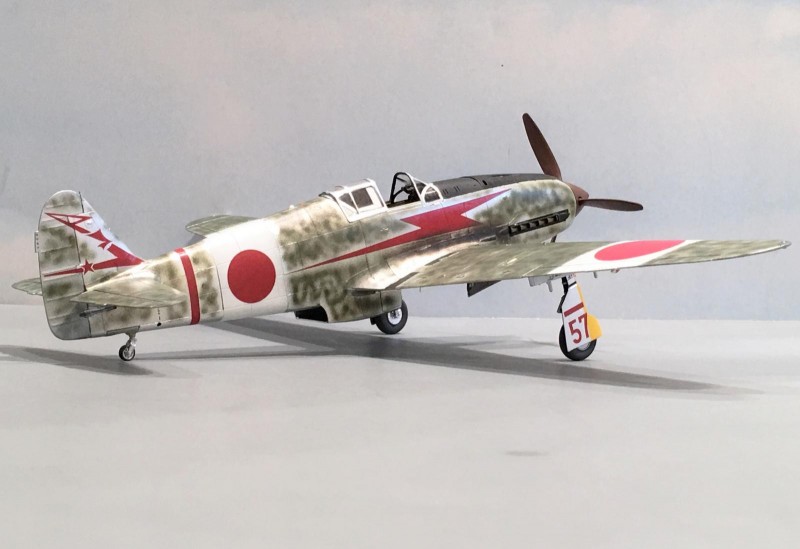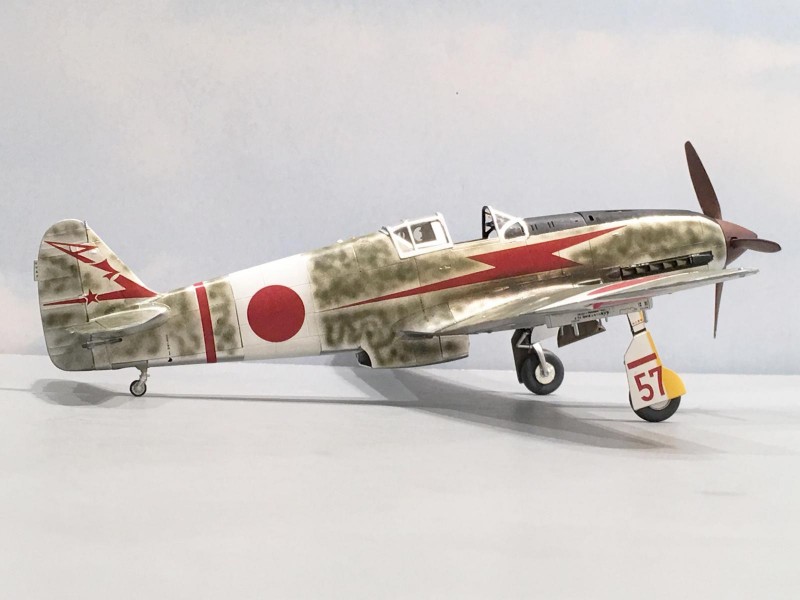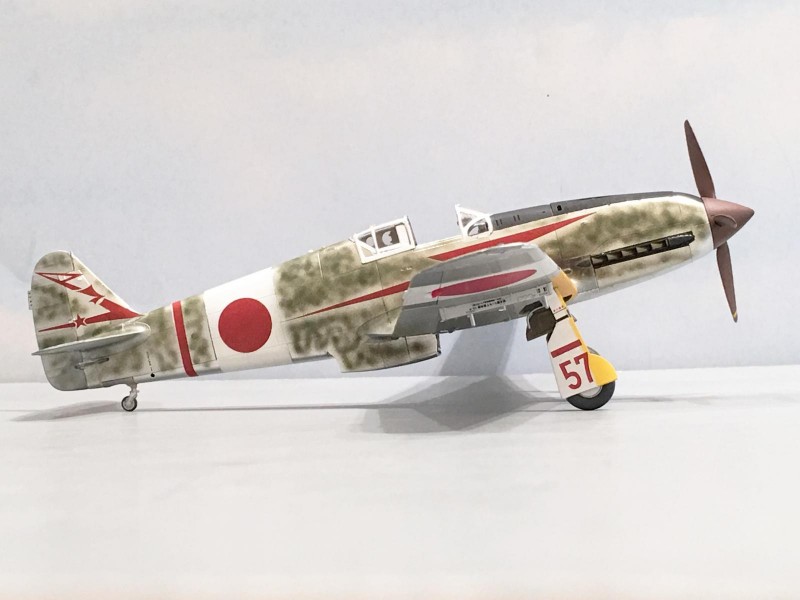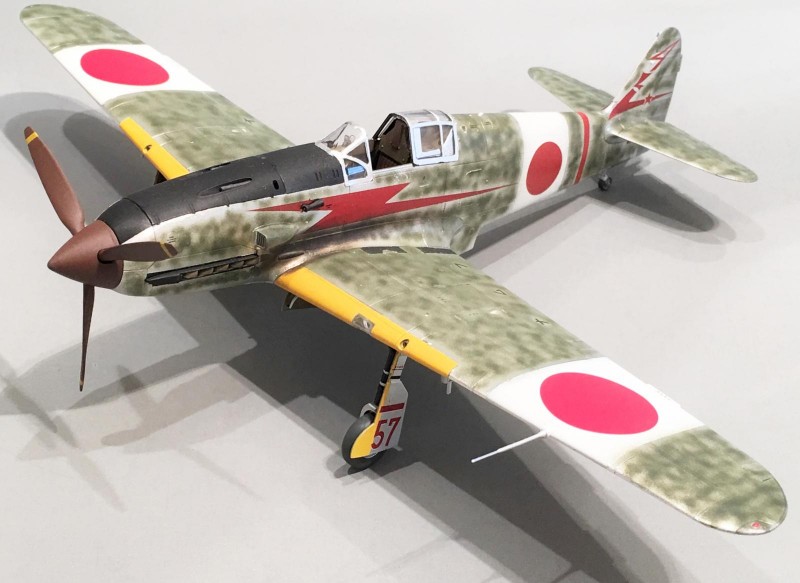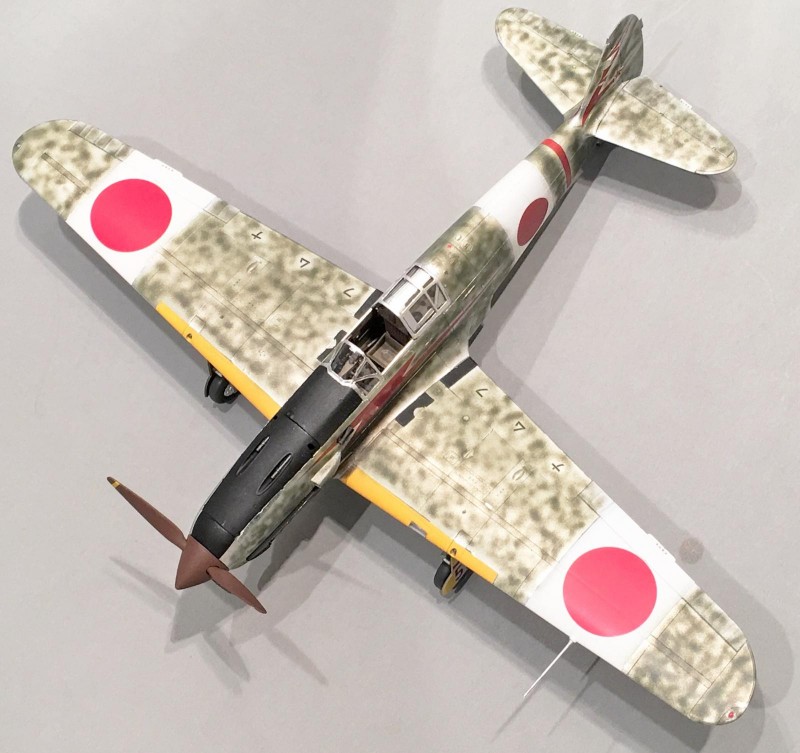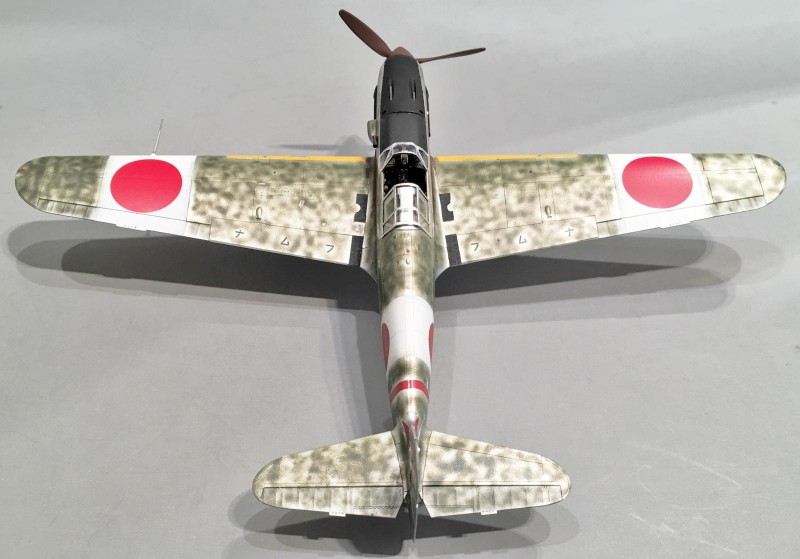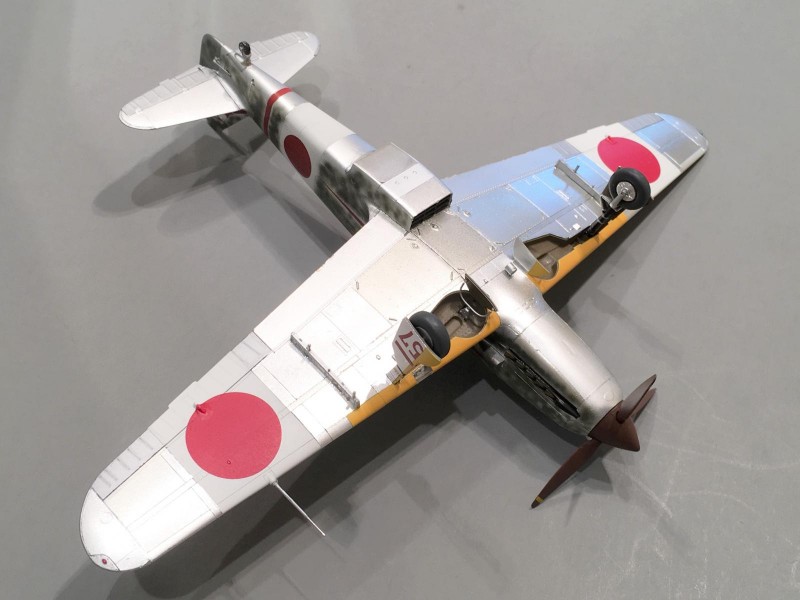Tamiya 1/48 Ki-61 Hien “Tony” 244th Sentai 1945, covered using Bare Metal Foil
This article is part of a series:
This is a model that I finished up a few days ago. It also happens to be my favorite Japanese fighter from the War. It's so elegant and streamlined... I call it the "Japanese Spitfire".
The Tamiya model fit together perfectly, and the engineering is so clever and precise that I didn't feel the need to glue several parts in place. I still used glue throughout the build however just to be safe.
The Ki-61 was a Japanese fighter that was powered by a Kawasaki Ha-40, which was actually a license built German Daimler Benz DB-601 engine with a few changes incorporated. The Japanese version of the DB-601 weighed in at approximately 70 pounds lighter than it's German counter part.
These changes made by the Japanese, caused the engine to be manufactured at even more critical tolerances, which was something that hampered production by making it even more complicated to build. The Japanese engine also required a higher octane fuel which was something the Japanese Military had a shortage of during the War.
When the plane was first encountered in combat, it was often mistaken as a BF-109 ! This is also why the plane was given the Allied code name of "Tony", since the engine was also used in several Italian fighters of the time, and the plane was thought to be of Italian or German design.
The airframe went through several changes during the production lifespan. One which occurred later on was the lengthening of the nose by approximately 8 inches to allow the installation of a larger caliber weapon in the nose of the aircraft. The Germans sent a shipment of Mauser cannons via U-Boat to the Japanese. The Japanese immediately placed these new canons into service and saw results right away with the improved fire power.
However the majority of the Ki-61's that saw combat were of the "short nose" variety... Most of the model versions in 1/48 scale today are of the long nosed plane. This Tamiya offering is no exception.
I wanted to build a version of the "long nosed" Tony. I wanted something besides the regular ones you normally see with the red tail that is commonly associated with the 244th Sentai. I had a set of older Aero Master decals that dated back from 1995. These showed a long nosed Tony with tail markings from the 244th Sentai. The plan was coming together... fortunately for me the old decals worked flawlessly. I found that Lifelike also produced a more recent set of decals for this exact plane. They also had the markings shown the same as what Aero Master did, so I felt better knowing this. Lifelike has a reputation for doing considerable research behind their subjects.
A while ago I did an in box review on the kit shortly after it was released. Every since then I have been wanting to build this kit since I was very impressed with the contents inside . I finally said "to heck with it" and simply opened the box. Sometimes taking the first step is the hardest thing to do.
The 244th Sentai was formed shortly after the Doolittle Raid. Originally it was the 144th Sentai and they operated the older Ki-27 "Nates". The Doolittle raid had impacted the Japanese in such a fashion that a lot of critical resources were used for homeland protection.
The main reasons we see so many pictures of Ki-61's from the 244th Sentai is that this unit was based near Tokyo. As such and since they were tasked with homeland defense, they became the subject of photography in a lot of instances. This became even more evident as the Americans started the B-29 raids over Japan.
The Japanese had a very hard time trying to reach the altitudes that the B-29's operated at. They also suffered the effects from the Jet Stream just as the American bombers did. There were accounts given that the Japanese planes just could not operate at these "extreme" altitudes where the B-29's were encountered. Often the fighters would simply not be able to climb any higher and would stall out, causing them to plunge back to earth... until they regained control when the air became more dense.
The Japanese were very desperate in their attempt to down the B-29's. They had to remove unnecessary weapons, radios and armor in an effort to reduce the overall weight of the aircraft to help with the service ceiling. If you look closely at the model you will see that there is no radio mast. This is why. Not all of these planes had one...
This is a sight that was often the last for an allied airman... a Ki-61 coming in head on. Since the majority of the weapons had been removed, the Japanese pilots often resorted to "ramming" attacks. On occasion they would simply used the propeller to slice up a B-29. When this happened, the pilot would try to bail out if at all possible...
There were a few documented cases where Ki-61's were successfully landed after a ramming attack was carried out against a B-29. These pilots were considered National Hero's and often awarded the "Bukusho" which was Japan's highest award. This award was the Japanese equivalent to the American "Medal of Honor". The Bukusho was awarded in two categories. Class "A" and a Class "B". The pilots most often received the Class "B" version.
There are a few pictures floating around of these planes as they were placed on display throughout various Japanese cities later in the War. If you are at all interested in this B-29 aerial campaign over Japan, I can highly recommend you get the Osprey book entitled "B-29 Hunters of the JAAF". It was written by Koji Takaki and Henry Sakaida.
It is well illustrated and has numerous photos showing the various B-29 planes that were attacked, as well as the assorted Japanese planes that were used to attack the B-29's. The book also gives details about what happened to the B-29 crews once they were taken into captivity. Let me just say these B-29 crews were not treated very well at all... but that's another story.
The Ki-61 was used by many Japanese fighter units. Some of the more famous Groups were totally wiped out, almost to the last man while serving the Emperor in New Guinea. Among the units that were completely wiped out by Allied airpower was the 68th and the 78th Sentai. These were sister units and often flew together in combat. They flew the Ki-61 when it was available, and also flew the older Ki-43 Oscar.
I have a set of decals for a 68th Sentai plane and will eventually build one using the older, but still acceptable, Hasegawa offering. In order to build this model I will have to use the "short nosed" version, which was in combat earlier and more often encountered in the skies.
These units were under the constant threat of aerial attack from the Allies. Most often the worst was received from low flying B-25's dropping para frag bombs. The B-25's would fly in at very low level, strafing the Japanese airfields and dropping bombs. The para frag bombs were small cluster bombs that had a time delayed fuse on them and were suspended by a small parachute as they dropped. When they went off, the damage caused by shrapnel to both the men and the planes was often enough to reduce the entire airfield to rubble.
To help prevent this from happening, the Japanese became very proficient at using camouflage. It varied from using freshly cut vegetation from the nearby jungles to conceal the planes, to spraying on various squiggly lines and shapes over the natural metal finish that the "Tony's" were delivered in. This was often done using as little paint as possible. Just enough to knock down the "shine". Sometimes this paint was applied using a brush, while other times it was sprayed on.
I tried to replicate the look on my model here by doing the same. If you look close, you can see the stencils are still readable... In this next picture you can see just how effective this process actually was... On one side I left the plane in a highly polished finish that was created by using the Bare Metal Foil. On the other side I simply sprayed on a light coat of green squiggly lines of various intensity.
I wanted to make this plane look as if it was flown, but not "War Weary". So I added some exhaust stains using Tamiya weathering decks to create the exhaust patterns. You can see this darker streaking in the lower portion of this next picture. You can also see how the area around the canopy was left in a Natural Metal Finish. I also tried to recreate a few very small scratches into the green sprayed on paint. If you look very close... you can see a few where the pilot would have caused them as he entered the cockpit.
Tamiya has captured the cockpit very nicely. This is exactly how it looks right from the box. No aftermarket parts were added. However, if I were to build this one again, I would add a different seat harness ...
Again, contrary to popular belief, the interiors were not painted using RLM 79... This color is very close to the original from recent discoveries of relics that were found in an attic in Japan ! There's more about this color choice I made, and actual pictures of these original Ki-61 items posted in my build journal...
These next pictures show the plane as it looks from directly overhead, and from various angles. From this vantage point you can see just how effective the green paint was at reducing the shine. No other coatings were used on the top side of the model other than a very light coat of green... The shine of the bare metal was highly reduced with a minimal effort.
The kit comes supplied with a single clear side fuselage half. I didn't use it for obvious reasons. The nice thing about this is with a little effort, Tamiya should be able to release a new tool "Short nosed" Hien or even possibly a Ki-100, since the rest of the airframe was almost identical...
How cool would that be ?
So if you are looking at this Mr. Tamiya, I'm sure there would be a market for these additional planes, and it would be a minimal investment to provided them... Just think about the possibilities !
Thanks ... 🙂
As far as the underside of the airframe is concerned, it was too shiny "as is" by using the various shades of Bare Metal Foil. Taking advice from Tom Bebout, @tom-bebout
initially I tried using a "Semi-Gloss" spray coating to knock down the shine somewhat. This helped, and was a step in the right direction, but it needed more to achieve the look I was after...
So I went back a second time, and lightly applied another very light coat using Testor's "Dull Coat" right from the spray can. This gave me the results I was after... The light was still reflected from the foil, but now it had a more "oxidized" look to it...
If you look closely at these next few pictures, you should be able to see what I'm talking about... But for the best and most natural look, this one has to be seen in person... and in natural sunlight. It really Pops !
Here in this next picture you can see the effects of the exhaust stains and also see the "Venturi" that was often used on these planes as flown by the 244th Sentai. Rumor has it that the Commander named Kobayashi, was formerly a bomber pilot and trusted the venturi device more so than the typical "pitot" tube in use on these planes. So planes from the 244th Sentai will occasionally have both items that were necessary for proper operation of certain instruments...
The Venturi is painted flat black and is located in the red flash on the side of the fuselage. The Pitot tube is located on the leading edge of the wing...
You can also see the nice details provided by Tamiya that replicate the landing light and exhausts ...
and how nice the landing gear and wheel wells are depicted...
A drop tank under wing mounting bracket was included. I decided to not add the drop tanks, but still might do so at a later date. Tamiya even provided stencils for the bracket which is a nice touch...
These next photos show the kit during the construction phase. Here you can see exactly how shiny the finish was by using the three different shades of Bare Metal Foil.
I used "Ultra Bright Chrome" in some panels, and 'Chrome" in others. Lastly I used "Matt Aluminum" for the remaining areas that had to be covered.
I tried to mix things up and not have two panels located next to each other in the same color, to give the illusion that each panel was a separate sheet of aluminum as it was on the actual plane.
I also used "Aluminum Dope" color to spray paint the fabric covered flight control surfaces. Contrary to popular belief, from what I have read on Jaircraft.com, the Ki-61's didn't use "Japanese Army Light Gray" as most believe. If you think otherwise, try looking close at several B & W pictures of planes from the Akeno Flight school. These planes were operated in the Natural Metal Finish as delivered for the most part...
Here you can see the decals as they were applied... Believe me, it was hard to start spraying on the green over this beautiful Foil...
Part of me wanted to leave it alone, since I really like this look... But I wanted mine to look more authentic, so I decided to start covering this beauty with some green. Now I'm happy that I did... But I will be building a P-51 and this will be the perfect look for it.
Lastly, I leave you with this parting photo. It shows how I simply sprayed around the 244th Sentai unit markings... This is exactly how it was done during the War...
I hope you enjoy this article as much as I enjoyed the building and research process.
Tamiya hit a home run with this baby... Anyone that tells you anything different needs their head examined... 🙂 It's the best Ki-61 in this scale that I have built so far.
Now don't get me wrong, the older Hasegawa kit is still very acceptable. I'm not bashing the Hasegawa kit by any means. It still looks good when completed, but it is also a product of the early 1990's and has been eclipsed by this newer offering from Tamiya.
Go out and get yourself one of these... You'll be happy that you did.
Thanks for reading and for more information, please don't hesitate to check out the build journal on this one. Here's a link to it in case you're interested in how it was built, including the color documentation, and how I applied the foil...
https://imodeler.com/groups/work-in-progress-aircraft/forum/topic/1-48-tamiya-ki-61-build-review-kit-61115/
As usual,
Comments are encouraged.

